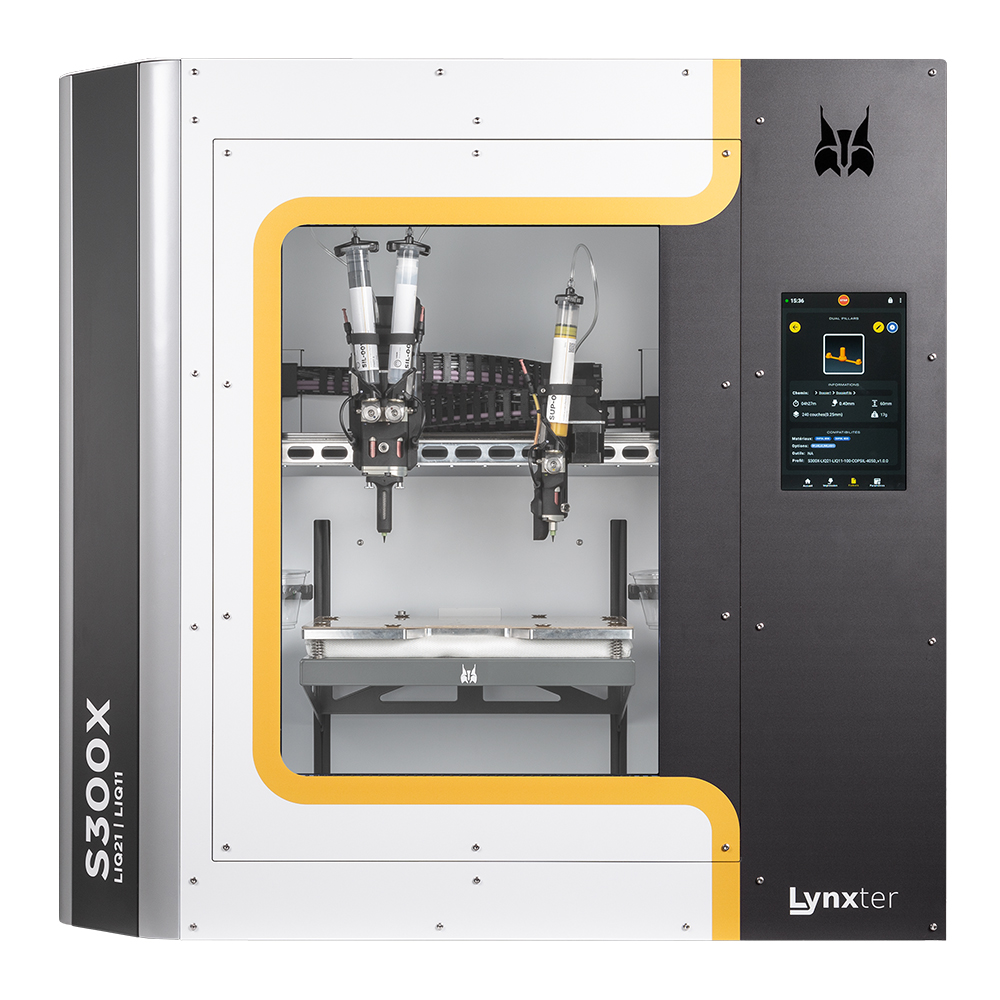Silicone 3D printing: Material Extrusion vs Vat Photopolymerization

We conducted this study with the help of Lynxter, a manufacturer of 3D printers designed for silicone additive manufacturing.
The industrial sector frequently turns to silicones for their reliable and diverse properties. Their ability to withstand extreme temperatures, coupled with their resistance to harsh chemicals and chemically inert nature, makes them the sole viable option in various settings. Their versatility is further evidenced by their wide shore hardness range and remarkable elongation capabilities, which enable them to absorb impacts and dampen vibrations. Consequently, silicones are ideal for a wide array of applications, from robust industrial seals and gaskets to applications with demanding HSE standards (medical, etc).
This article aims to provide a comprehensive high-level overview of the additive manufacturing technologies that are revolutionizing the production of silicone parts. We’ll compare the capabilities of Material Extrusion (MEX) and Vat Photopolymerization (VPP) for silicone AM, assessing their relevance and advantages over conventional manufacturing methods.
Silicone manufacturing: additive vs conventional
Additive manufacturing (AM) has brought new options to the table for silicone part production, complementing conventional processes. Traditional manufacturing techniques, such as injection molding and casting, have long been the staples for creating silicone components. These processes benefit from high throughput and repeatability, making them ideal for large-scale production. However, they come with significant initial investments for tooling and machinery, and are less adaptable to design changes, leading to higher operating costs for short runs and prototypes.
Additive manufacturing has emerged as a game-changer, offering the flexibility to produce complex geometries and custom parts efficiently. It brings the classic benefits of AM to silicone, such as lower initial costs, especially for rapid prototyping and small series production. Another important benefit of AM: the ability to produce isotropic silicone parts, similarly to conventional manufacturing processes.
Let’s dive deeper into the specifics of silicone 3D printing with the two main processes involved.
Silicone AM: Material Extrusion
When it comes to 3D printing silicone parts, Material Extrusion (MEX) stands out for its ability to adhere to high Health, Safety, and Environment (HSE) standards, offer a relatively quick return on investment (ROI), and cater to a broader market.
MEX shines in producing parts where traditional silicone properties, such as flexibility and durability, are critical. It boasts lower material and support costs, reduced waste, and less post-processing compared to VPP.
While the acquisition costs of MEX systems are typically higher when compared to desktop VPP solutions, the operational advantages and material efficiencies often justify the investment.
Silicone AM: Vat Photopolymerization
Resin-based 3D printing, or Vat Photopolymerization (VPP), provides a cost-efficient solution with an emphasis on surface finish, suitable for batches with lower durability demands. However, the resins used in VPP do not typically match the mechanical properties of Liquid Silicone Rubber (LSR) or RTV silicons used in conventional processes, potentially compromising performance.

Silicone 3D printing processes comparison
We’ve compiled a summary that outlines the materials, applications, advantages, drawbacks, and costs associated with each of these technologies.

Silicone AM: parts characteristics
In evaluating additive manufacturing for silicone parts, the choice between Material Extrusion (MEX) and Vat Photopolymerization (VPP) hinges on the desired outcome for the part.
Material Extrusion is well-suited for medium-sized components and offers a respectable resolution, with the distinct advantage of multi-material printing. While layer lines may be visible, MEX parts are robust, with high UV resistance and durability, making them ideal for applications requiring prolonged exposure to sunlight or mechanical stress and/or chemical resistance. MEX parts are safe for skin contact, and food-safe, broadening their applicability in medical and culinary fields, and are produced in an odorless process.

On the other hand, Vat Photopolymerization excels in crafting small parts with high resolution and smooth textures, appealing for detailed models or parts requiring aesthetic finesse. However, VPP parts typically exhibit lower UV resistance and medium durability. Although VPP materials can produce odor, they are, in some cases, still suitable for skin contact and food-safe applications.
Let’s recap the main capacities of each additive manufacturing process for silicone 3D printing:
In summary, 3D printing silicone parts with a material extrusion process unlocks functional versatility with durable, multi-material parts, whereas VPP favors applications where precision and surface finish are paramount.
Silicone 3D printing: mechanical properties
Let’s examine the mechanical properties of silicone and similar materials used in Material Extrusion and Vat Photopolymerization. We’ve gathered information from specification sheets for materials that are suited for a range of systems, from basic to advanced industrial setups.
Material Extrusion (MEX) technology broadens the scope of industrial applications with an impressive range of Shore hardness from 5A to 70A, catering to everything from very soft to medium hard parts. Its versatility is complemented by remarkable elongation at break and robust thermal resistance, positioning MEX as a strong contender for producing high-performance silicone parts across various sectors.

The comparison between Material Extrusion (MEX) and Vat Photopolymerization (VPP) reveals distinct mechanical advantages in favor of MEX, particularly in its wider Shore hardness range from 5A to 70A, allowing for the creation of both softer and harder parts. MEX parts boast higher tensile and tear strength, indicating better overall durability and resistance to mechanical stress. Additionally, MEX offers superior thermal resistance, withstanding a range from -60°C to 250°C, compared to VPP’s -30°C to 180°C, making it the preferable choice for environments experiencing extreme temperatures. This suggests MEX’s stronger suitability for varied industrial applications where performance under stress and diverse temperature conditions is critical.
In short
The choice between Material Extrusion (MEX) and Vat Photopolymerization (VPP) for silicone 3D printing depends on specific application needs.
MEX is ideal for high HSE standards, quick ROI, and applications requiring flexibility and durability. VPP offers a cost-efficient solution with a focus on surface finish, aesthetic finesse suited for applications with lower durability demands.
Spotlight on Lynxter’s S300X
The S300X stands out in the silicone 3D printing hardware landscape as a cost-efficient choice for top-tier silicone 3D printing. It comes equipped with an Independent Dual Extruder (IDEX), enabling the printing of multi-material parts with water dissolvable supports.
Tailored for crafting functional end-use parts, this advanced printer offers a versatile open material system to meet varied client requirements, coupled with a high deposition rate for streamlined production.
Additionally, its build plate is designed for quick and easy changes, enhancing its suitability for production lines. The S300X operates without solvents, promoting a more environmentally friendly and clean production process.
 English
English  Français
Français


